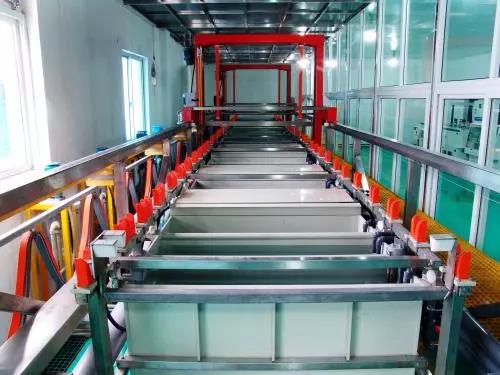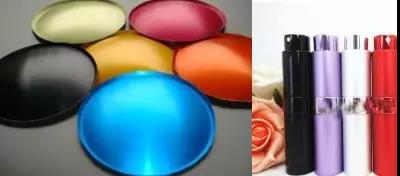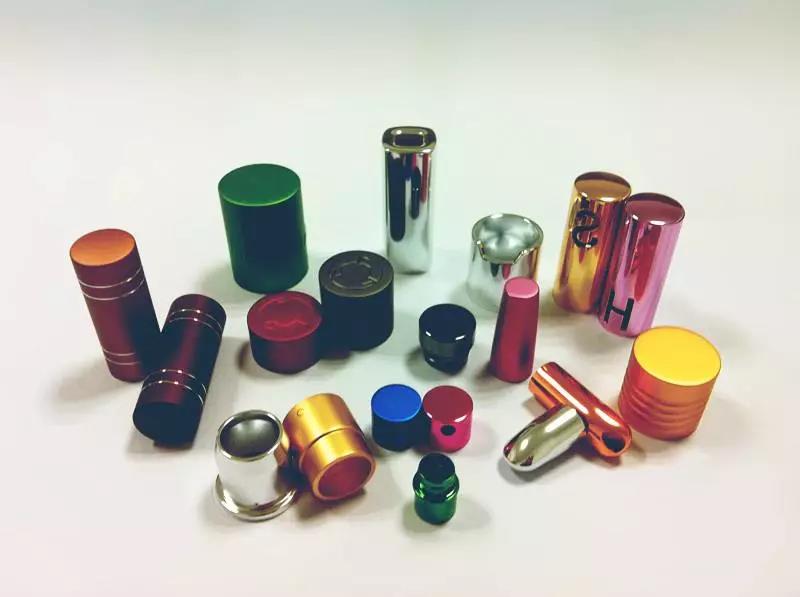Anodic oxidation process of
lipstick aluminum tube In order to make the products more personalized, most of the molded packaging materials need surface coloring treatment. There are various surface treatment processes for daily chemical packaging materials. Common processes in cosmetic packaging materials industry include vacuum coating, spraying, electroplating, anodic oxidation, injection molding and color modification.
- Process Definition
Anodic oxidation process refers to the metal or alloy parts as an anode, using the method of electrolysis to form oxide film on its surface. Metal oxide film changes the surface state and performance, such as surface coloring, improve corrosion resistance, enhance wear resistance and hardness, protect the metal surface.
2.Process characteristics
Anodic oxidation process, can make the product to increase the corrosion resistance, hardness and wear resistance, the hardness of
aluminum substrate is HV100, ordinary anodic oxidation film hardness about HV300, hard oxidation film can reach HV500), decorative, can protect the polishing of the surface gloss of the, also can be dyed, colored, obtain and maintain of rich and colorful appearance, electrical insulation, transparency, and functional
3.Process system composition
- anodic oxidation equipment


The chemical properties of
aluminum are active, and a dense oxide film about 5nm thick is formed on the surface of aluminum in dry air immediately, so that
aluminum will not be further oxidized and can withstand water;
Aluminum powder burns easily when mixed with air; Molten aluminum can react violently with water, reducing many metal oxides to their corresponding metals at high temperatures;
Aluminum is amphoteric, soluble in both strong bases and dilute acids.
Aluminum has good corrosion resistance in the atmosphere, but the strength of pure aluminum is low, and only by alloying can we get various
aluminum alloys that can be used as structural materials.

An oxide film produced by
oxidation of aluminium and its alloys. High porosity, strong adsorption capacity, easy to dye. The dyeing method is to put the anodized parts into an aqueous solution of organic dyes for dyeing or electrolytic staining.
4.Process Flow
- Flow chart
- Relevant instructions
Aluminum: Aluminum alloy is characterized by low density and high strength.
Aluminum has a density of 2.7g/cm3. Good ductility, high plasticity,
aluminum and its alloys can be achieved by extrusion, rolling into various type of materials), conductive good (after gold, silver, copper), corrosion resistance, being less intelligent remained statistically significant after oxidation film has good corrosion resistance, generally no response) in the air, surface treatment (such as anodic oxidation, electroplating, electrophoresis, spraying, improved the
aluminum decorative and protective effect)
skim
Remove oil stains and impurities on the surface of processed products and scratches, metal prickles, metal oxides, etc., to lay a good foundation for anodic oxidation coloring, so that its luster meets customer requirements.
Turn left
The workpiece is soaked in phosphoric acid solution to eliminate mechanical defects on the surface of the workpiece, reduce surface roughness, and improve its surface gloss.
Anodic oxidation The principle of
anodic oxidation of aluminum is essentially the principle of hydrolysis. When an electric current passes through, hydrogen is released at the cathode; At the anode, oxygen is precipitated not only as molecular oxygen, but also as atomic oxygen (O) and ionic oxygen, usually represented as molecular oxygen in the reaction. As the anode
aluminum is oxidized by oxygen precipitation on it, forming anhydrous alumina film, the generated oxygen is not all the interaction with
aluminum, part of the form of gaseous precipitation.
Before after
anodic oxidation, coloring, acid oxide film processing will activate are available, and all the organic/inorganic acid and acid salt can be used as an activator, due to the effect of chemical dissolution of the acid solution of alumina, oxide film hole hole wall from dissolved inside extroversion, extend the aperture, and can control the length of the activation time, gaining the aperture size of alumina membrane, achieve reaming, Increase porosity, so as to improve the effect of dye adsorption capacity.
dyeing
The chemical coloring of
aluminum anodized film is based on the ability of porous film to absorb dyes like textile fiber. The pore diameter of the general
anodic oxidation film is 0.01-0.03μm, and the dye is separated into a single molecule in the water with a diameter of 0.0015-0.0030μm. When dyeing, the dye is adsorbed on the pore surface and diffused to the pore, accumulated, and bonded with aluminum oxide ionic bond and hydrogen bond to make the film color, and the dye is fixed in the pore.
Hole sealing
Sealing the pores of
anodic oxide film and fixing the dye in the pores is an integral part of the dyeing process. The most simple hole sealing treatment is in boiling water treatment, as long as the appropriate, can ensure that the dyeing film shows the due color firmness, but also can make the workpiece has the ability to prevent fat printing, color spots and oil dyed. Anodized surfaces lose their ability to influence contacts only when they are adequately sealed.
5. Process Application

In cosmetic packaging materials, metal accessories are often used as components outside the product. For example, the metal component of lipstick tube, makeup tool component and outer component of bottle cap, etc., the
oxidation process not only increases the beauty of the metal component, but also protects the time tolerance of the metal component.



